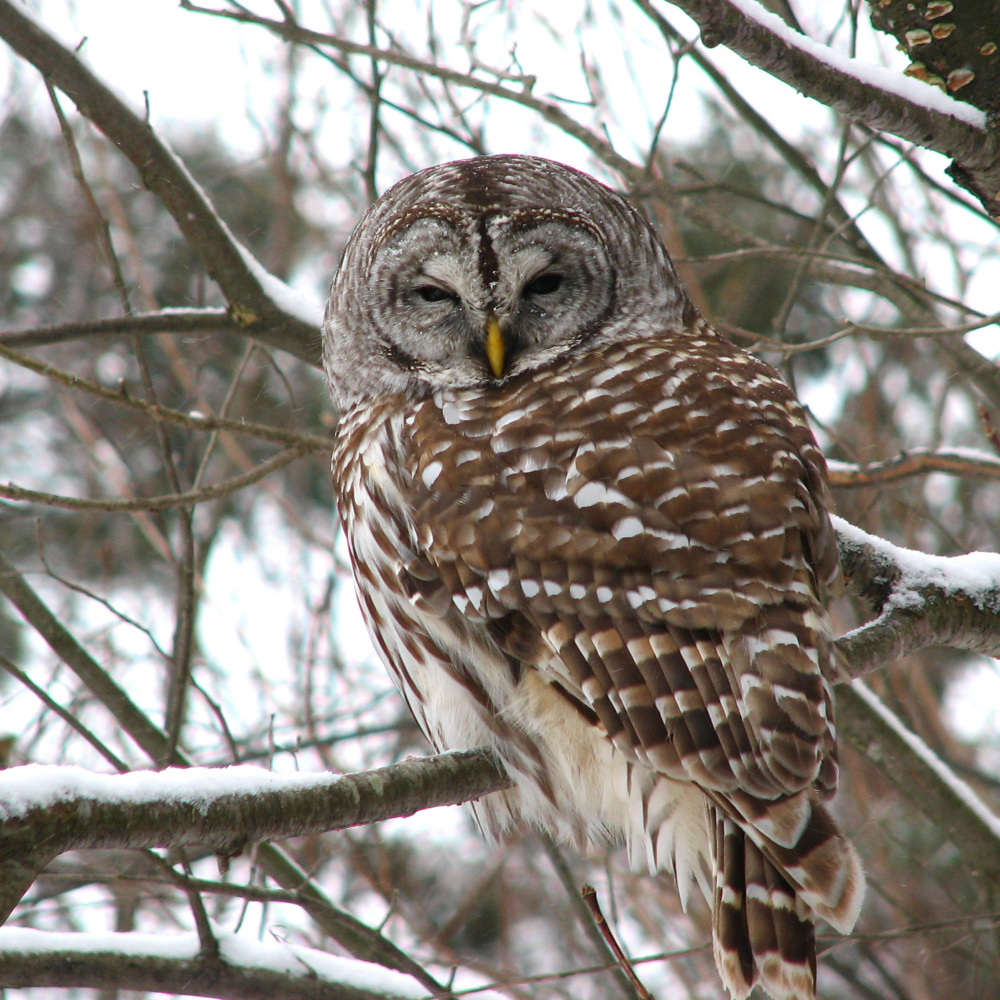Long ago when I was really a sub-novice bird-watcher (unlike now when the best you can say is that birds fascinate me and I recognize a few shapes, feathers and calls), I was walking around in the Vermont woods early one morning with a bunch of actual birders. They pointed out a redstart, a few warblers whose names I instantly forgot, and a turkey vulture. Somewhere in the middle distance, a rhythmic hooting sounded that even I could tell was coming from an owl.
“It’s a bard owl!” one of them said.
Bard owl, I thought. That’s a cool name for a bird whose call sounds hauntingly poetic to begin with.
“I wonder what play he’s quoting from,” I said. They all looked at me blankly, like I was out of my mind. Well, no matter, it’s happened before, and no one’s ever held a grudge against my verbal incomprehensibilities. That I know of, anyway.
Years later, I was reading about owls in Maine because we were hearing one at night in the woods. Hooo hooo hoo-hooooo. Great horned owl. Northern saw-whet owl. Long-eared owl. Short-eared owl. Barred owl. Eastern screech owl.
Wait a minute. “Barred” owl?
So this bird I registered as Shakespeare’s relative was not a bard at all, but barred. Funny thing about sounds.
If you listen carefully to the musical phrases, there’s a difference between “bard owl” and “barred owl.” “Bard owl” is a phrase you’d tend to pronounce with stress on the first word and less stress on the second — BARD owl. In poetics, this unit of rhythm is called a trochee. This is what the birders in Vermont were articulating.
What they thought they were saying, however, was “barred owl,” which in everyday American speech would normally be pronounced with roughly the same stress on both words — BARRED OWL. This stress pattern is called, technically, a spondee. In barred owl, most of us might let the second word fall off almost imperceptibly, reducing the distance between what the two phrases sound like, and mean — bard and barred.
These probably seem like irritatingly minute distinctions to most people, and some will scan the phrases differently. But the truth is, sounds carry profound meaning even in the fine details. Poetry, in one way of saying it, is language articulated at a level of musicality between everyday speech and singing. In the right conditions, speech can erupt into poetry at any moment. A shift in stress can mean the difference between a bird along the driveway and Shakespeare.
The barred owl (Strix varia) calling in our woods this summer is likely to be the same one we heard last summer, and during the lunar eclipse. Barred owls do not migrate, according to ornithologists, and have not been observed to travel more than six miles from areas where they’ve been studied. They live in forests of mixed trees, like ours, often near water, and prey on animals that are pretty abundant here, such as squirrels (overabundant, frankly), chipmunks, mice, other birds, frogs, toads, and even fish, bugs and worms. They tear the heads off the larger animals and eat them first, and they’re known to stash leftovers in trees. They fare badly in neighborhoods with great horned owls, who prey on them and their eggs, and on the other hand are a similar problem to spotted owls out west, where they’ve been encroaching in the past century.
The barred owl song that haunts our woods at night is usually transliterated into English as “Who cooks for you?, Who cooks for you — all?”, with an extra syllable dropping from the end of the echoing line. In poetics, that falling-off stress at the end is called a feminine ending. One study sorted out six distinct barred owl vocalizations, including a variation on the nine-syllable song with ascending, more uniform stresses; “duets” of calls and responses between two birds; “a two-syllable ‘hoo-aw'”; “a one-syllable, sharply ascending wail”; and “an irregular and patternless assemblage of hoots,” described by other observers as chaotic screaming.
We don’t know what goes through the calling bird’s mind or the effect of the call on the bird that hears it. It’s not random babble, though, which implies the owls understand what the fine details in the sounds mean. A long time ago, some birders in Massachusetts used a whistle to elicit replies from a barred owl, and discovered the pitch of the replies was B-natural. A later formal study determined female barred owls call at a higher pitch than males. Song is the owl’s everyday speech.
Their primordial lines of poetry have been sung in these woods for who knows how many millennia, 11,000 at least, going by fossil records. Hooo hooo hoo-hooooo, hooo hooo hoo-hooooo-aww. An echoing ghostlike gorgeousness, like the sound of an eclipse. It has Shakespearean depth, gravid with the kinds of meaning singing produces, even when you don’t know the language.
The birders in Vermont articulated it exactly accurately.
Dana Wilde lives in Troy. You can contact him at naturalist1@dwildepress.net. Backyard Naturalist appears the second and fourth Thursdays each month.
Send questions/comments to the editors.




Success. Please wait for the page to reload. If the page does not reload within 5 seconds, please refresh the page.
Enter your email and password to access comments.
Hi, to comment on stories you must . This profile is in addition to your subscription and website login.
Already have a commenting profile? .
Invalid username/password.
Please check your email to confirm and complete your registration.
Only subscribers are eligible to post comments. Please subscribe or login first for digital access. Here’s why.
Use the form below to reset your password. When you've submitted your account email, we will send an email with a reset code.